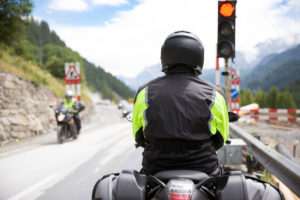Bicycling is a fun, healthy and an environmentally friendly way to spend time outside. The city of Atlanta is one of many cities across the country that has seen an increase in cyclists. The National Highway Traffic Safety Administration (NHTSA) has declared May as National Bicycle Awareness Month. The increase of bicyclists both locally and nationally is exciting, but safety for those cyclists needs to be at the forefront of our minds.
Every cyclist should be well-equipped with a bike safety kit. The kit is a suggestion from the NHTSA to help riders of all ages be more prepared if something was to go wrong. So before you head out the door on your next ride, make sure you are properly prepared for the pavement.
Wear a Helmet
- Whether you have no experience or decades of experience on a bicycle, it is important to always wear a helmet.
- Wearing a helmet is essential to riding because it can help prevent significant head trauma.
- In the state of Georgia, you are required to wear a helmet while riding a bike if you are under 16 years of age. However, we suggest that you wear a helmet regardless of your age.
- Make sure that your helmet is on correctly and fits properly.
Stay Hydrated
- Water is an essential part of a bike safety kit because riding can be strenuous—especially in the Georgia heat.
- Do not allow yourself to become dehydrated. Always have enough water with you in case you pop a tire and are stuck on the side of the road.
Tools
- Bicycles have many parts so it is essential to have some tools in your safety kit in case something goes wrong.
- Whether you are an avid bicyclist or out for a leisurely ride, it is crucial to have a puncture repair kit, pocket maintenance and mini repair kit with you. These items can easily be stored in a small bag.
- Before you venture out, properly inspect your bike. Make sure that tires are properly inflated and that your gears are working properly.
Reflect
- Gear Up – Motorcyclists should always wear proper protective gear before getting on the road. A helmet is essential, along with pants, a jacket, boots, and riding gloves to reduce the risk of serious injuries like road rash.
- Be Seen – Whether riding a motorcycle or bicycle, visibility is key. Reflective clothing, front and rear lights, and additional reflectors help drivers see you and maintain a safe distance. Georgia law requires bicyclists riding at night to have a front reflector, and adding more lights and rear reflectors can increase your safety.
- Check Weather Conditions – Weather can dramatically affect riding safety. Always check the forecast for your route and destination. Even light rain can reduce traction and make braking more dangerous, while Georgia’s spring and summer storms can bring hazardous downpours.
- Keep Your Distance – Many motorcycle crashes happen because “the car didn’t see the bike.” Maintain plenty of space around you, especially during lane changes, braking, or speed adjustments, to give yourself room to react.
Watch Intersections and Blind Spots – Intersections are high-risk areas for riders. Make yourself visible, avoid lingering in blind spots, and keep extra space from larger vehicles, which have more difficulty seeing motorcycles.
A well prepared bike safety kit not only promotes safety, it also helps riders in times of need. More information can be found nhtsa online.
For more information about this article, contact Kaine Law.
Call or text 404-214-2001 or complete a Free Case Evaluation form




